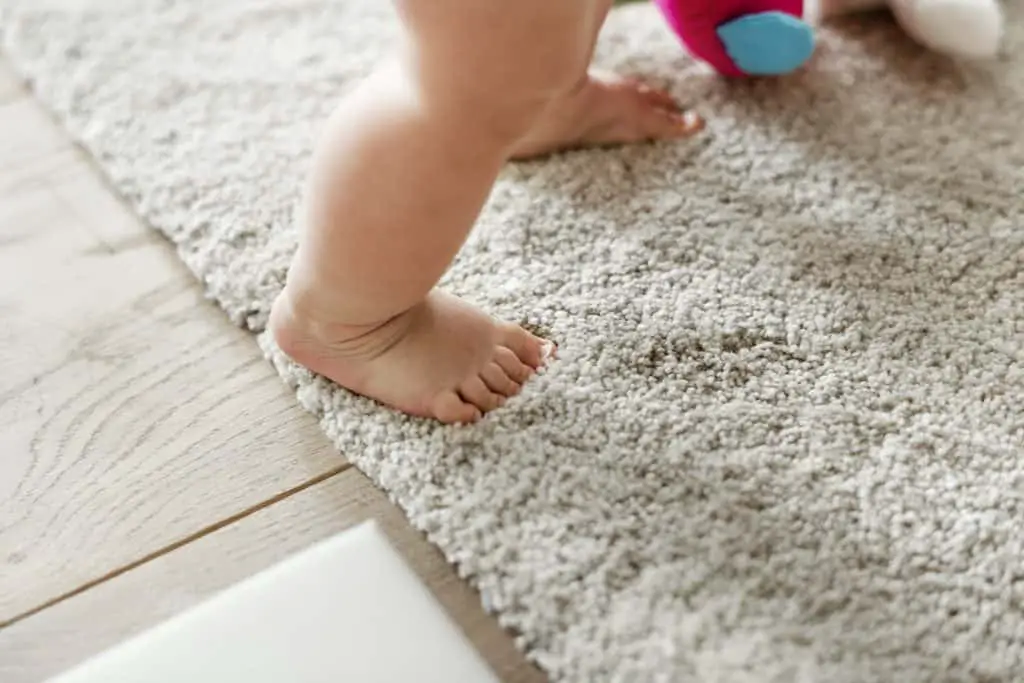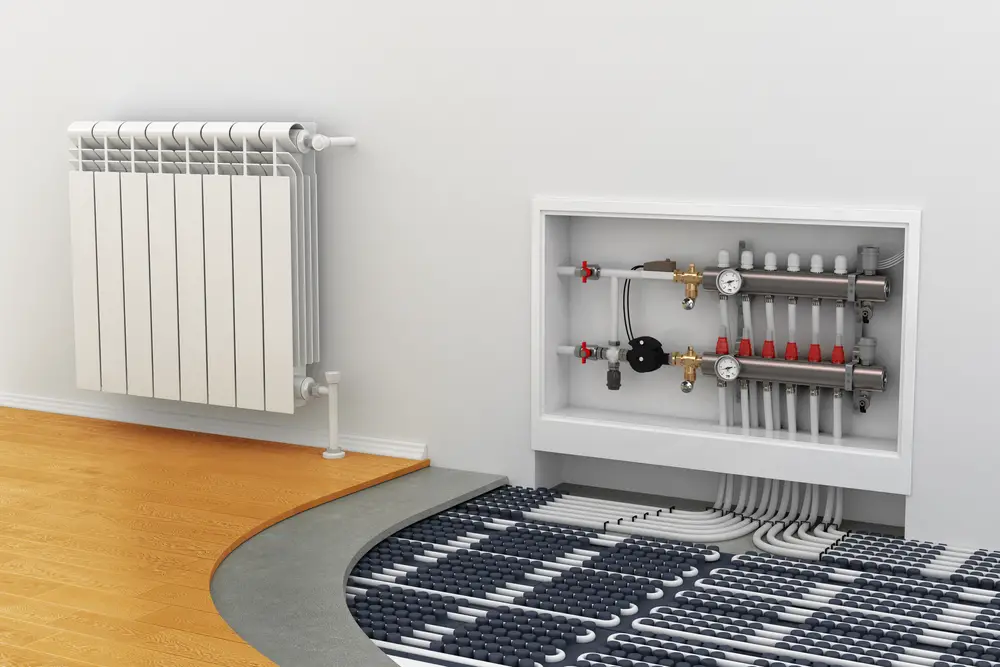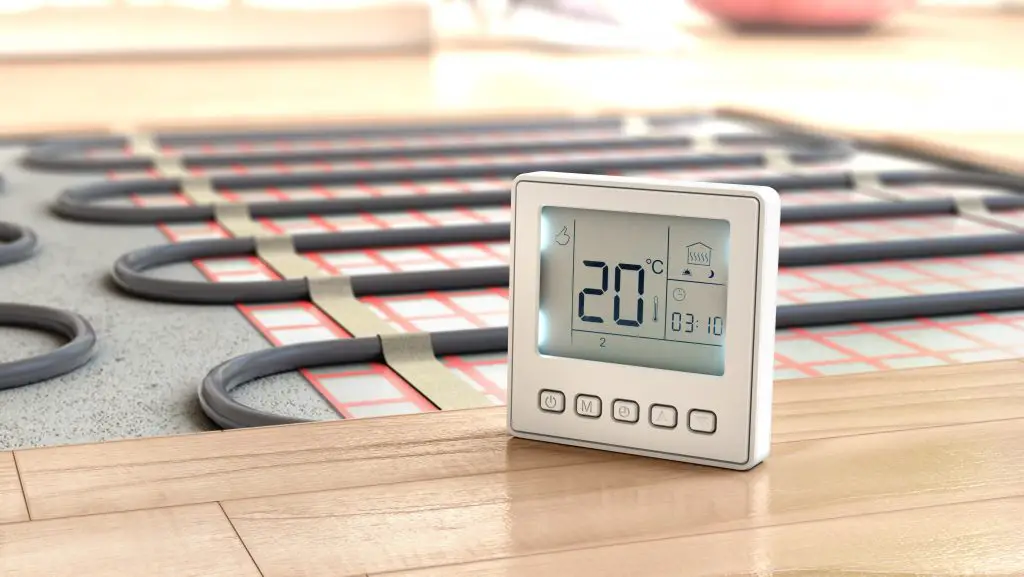The ideal underfloor heating temperature is different from place to place and person to person. Harsher climates require a comparatively higher average temperature, and each customer also has their own preferences for their ideal temperature. Talking strictly from a view point of efficient and cost effective use, there are some guide lines that can be followed.
Underfloor Heating is often left on for long periods to provide background warmth, you may choose a temperature setting of 16-27 degrees Celsius (60-80 degrees Fahrenheit) for home heating, depending on the room. This could rise to a max of 32 degrees Celsius (90 degrees Fahrenheit) for fast warming.
You can always use your underfloor heating system at lower temperatures than this, especially in warmer climates or if you benefit from more conductive flooring. How hot you need to set your underfloor heating thermostat depends on your climate, your flooring choices, insulation, type of underfloor heating, and other factors we cover in this article.

An electric underfloor heating system works on the principle of heated wires that conduct heat through the floor. Water or hydronic underfloor heating systems are based on heated water flowing through the pex pipes under the floor to heat up the floor by transfer of heat. This is better than a radiator as it will provide more uniform heating of the whole room, rather than one hot area and one cooler.
How long does it take underfloor heating to warm up?
Water underfloor heating systems require 2 to 3 hours to heat up the room. This is because the water pumping through the pex pipes under the floor is nowhere near as hot as the wires in electric underfloor systems. Yet, this system is more economical to run.
The electric underfloor heating can achieve the set temperature in around 30 to 60 minutes, this is because the wires that heat up under the floor run on electricity and they operate at a higher temperature as compared to water underfloor heating system.
Check out our dedicated article on the speeds of warming for different types of underfloor heating here.

Should the floor feel warm with underfloor heating?
Yes, the underfloor heating is able to turn the floor a little warm to the touch by the continuous heat dissipation from the heating system. As the underfloor heating is installed to give a nice cozy feel to the residence, the flooring can heat up to a level that can be categorized as warm.
Though this is a huge selling point for the company marketing underfloor heating, the customer may not especially want warm floors, just warm rooms. Some customers prefer a warm floor and some are content just to have enough heat to warm up the room. Your choice of flooring is important here as some will conduct more heat and feel warmer than others. Either way, the option is always available with underfloor heating and if needed the floors can warm up.
Additionally, having warm floors would require a higher temperature level to be set on the thermostat, this would lead to added heating costs as more energy would be required to heat up the floor enough that it feels warm. This is a key factor that stops people from heating up their floors enough.
In addition to this, excessive heating of the wood flooring removes the moisture content from the wood, this can lead to cracks and even warping of floor boards over time. So, it is advised that in the case of wooden, especially timber floors, the heating can be turned up, but not to extremes.

What is a good temperature for a heated floor?
Underfloor heating slowly radiates heat upward into the room, this means that the underfloor heating temperature should be at a higher potential than the room. Many things factor into the equation, the ventilation, insulation of the room, quality of conduction through the floor and the ability of the floor to retain humidity etc. The ideal temperature for a room is a theoretical concept, that is because the temperature varies from season to season, so keeping in mind that the temperature of the room will change over time, a temperature range was needed that could be applied at all times.
Considering all this, many underfloor heating owners operate their systems at between 23 to 27°C (73-80 degrees Fahrenheit) for background heating and up to 32 degrees Celsius (90 degrees Fahrenheit) for periods of active warming. This is a sliding scale and mostly all residencies having underfloor heating operate at around these values. Though this is not a set rule as extreme weathers can lead to this value being completely ignored, and yet that is the better option.

What is the maximum temperature for underfloor heating?
Electric underfloor can generally heat up to higher temperatures compared to hydronic underfloor heating system. Electric underfloor heating can heat up a room up to a extreme level of 40°C, that means that the heating wires under the floor are heated up to almost twice that. This extreme heat is unnecessary and in some cases impractical, as most houses do not need such scalding temperatures for everyday use. The average temperature most residencies maintain using electric underfloor heating systems is between 23°C to 29°C.
Hydronic underfloor heating uses warm water to heat up the floor by the process of transfer of heat through the floor. As the water that is being pumped throughout the floor requires a continuous supply of heated water, gas heaters are used which makes them cheaper to run than electrical systems. Unlike a boiler or a radiator, the underfloor water system heats up the room equally and continuously, so hydronic underfloor heating does not require extremely hot water. The water pumping through the floor is around 50°C, which can ideally warm up the floor to around 25°C.
How hot can underfloor heating get? – Underfloor Heating Temperature Extremes
If the guidelines for operation are followed strictly, the underfloor heating systems are usually felt to be the safest method of domestic heating available. Special care should be taken during the installation as this is the most critical part of the process and this is where most of the potential problems can occur.
Insulation should be done properly, air gaps should be removed, and temperature nodes should be placed accurately for proper detection of the temperature.
With a maximum heating temperature of around 40°C, electric underfloor heating system should not catch fire through overheating (providing proper professional installation has taken place and safety instructions adhered to). If it has complete access to air and wiring is up to date, the underfloor heating will cause no problems for you.
Electric underfloor heating takes close to an hour to heat up the room, this is why heating at a moderate temperature still gives a cozy feel around the room. The wire in the under-floor heating can heat up to around 80°C.

Hydronic or water underfloor heating systems use warm water to heat up the floor. This water is heated to a max value of 50°C, as this is not at boiling level, there is no risk of burning or damaging of floor in case of breaks. The pex pipe used to transport this water is almost leak proof as this is a joint-less setup and no pressure points exist within the pipe.
The risk of fire within this system is at most around the same as that in a conventional radiator, as it uses the same system to heat the water that is used in a radiator. If the system is properly installed, the risk of fire in the movement of water under the floor is lower still.
Lots more Underfloor Heating Information Here
- What Depth is Required for Underfloor Heating?
- Turning on Underfloor Heating for the First Time – How Long to Wait?
- Can you lay Vinyl flooring over underfloor heating?
- Do Tiles Crack With Underfloor Heating?
- Can You Heat a Whole House With Underfloor Heating?
- Can You Have Underfloor Heating Upstairs?
- Will Underfloor Heating Raise My Floor? – Underfloor Heating Layers Explained
- Can I put furniture on top of underfloor heating?
- How Do I Know If My Underfloor Heating is Leaking?
- Can You Combine Underfloor Heating With a Ground Source Heat Pump?
- Is Underfloor Heating Safe?
- Does Underfloor Heating Add Value to a Property?
- Can you have Wooden Floors with Underfloor Heating?
- Can Underfloor Heating Cause a Fire?
- What temperature should Underfloor Heating be set at?
- Can I Put a Rug Over Underfloor Heating?
- How Long Does it Take for Underfloor Heating to Warm Up?
- Why is my Underfloor Heating Noisy?
- Why is my Underfloor Heating Patchy?
- How do I know if My Underfloor Heating is Working? – Common Problems & Fixes
- What can go wrong with underfloor heating?
- Can you Combine Underfloor Heating with an Air Source Heat Pump?
- Do you keep underfloor heating on all the time?
- Does Underfloor Heating work with Smart Thermostats?
- Kitchen Underfloor Heating – Should Underfloor Heating go Under Kitchen Units?
- How much energy does Underfloor Heating use?
- Underfloor Heating in Summer and Winter
- Lifespan of Underfloor Heating
